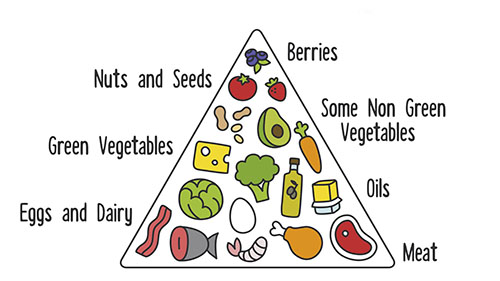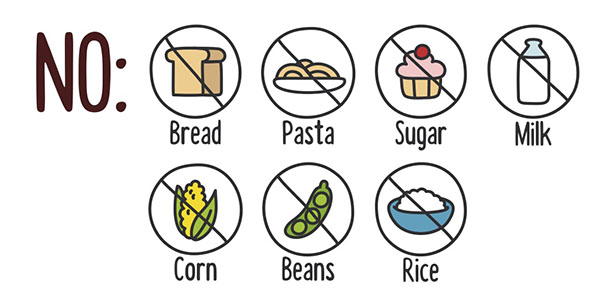What can you eat on a low-carb diet?
You might be surprised to learn just how diverse and delicious a keto diet can be. Depending on the state of your current diet, it may take a little getting used to, but a ketogenic diet shouldn't feel like deprivation.
A note about low-carb vs. ketogenic diets
Throughout this site, I use the terms “low carb” and “ketogenic” equally, but they aren’t always the same thing. A low-carb diet may mean different things to different people. You may find that certain health symptoms resolve when you eat fewer than 125 grams of carbohydrates per day. Other individuals — for example, people with type 2 diabetes — may need to limit their daily carbohydrate intake to below 25 grams in order to start experiencing benefits. The extent to which you decide to limit your carbohydrate intake depends on your health status and your individual goals.
A ketogenic diet, however, is typically characterized by consuming very low carbohydrate levels with the intent of achieving nutritional ketosis — a state where your body shifts from using carbohydrates as its primary form of energy to using fat.
A ketogenic diet consists of low carbs, high fat, and moderate protein. The typical macronutrient breakdown for a ketogenic diet is 5% carbohydrates, 75% fat, and 20% protein.
Keto diet macros
Carbohydrates
Most of your carbohydrates should come from leafy greens and green vegetables.
Fat
Healthy fats include meat, nuts, fatty fish, olive oil, coconut oil, and avocado.
Protein
Aim for healthy sources such as grass-fed beef, organic chicken, and wild-caught seafood.
Simple vs. complex carbohydrates
When we talk about carbohydrates, it’s important to remember there are different kinds: simple carbohydrates (like those in sugar, bread, and pasta), and complex carbohydrates, which are found in vegetables. If I can teach you one thing, it would be this: please don't think that going low-carb means you can’t eat vegetables. Your body needs the vitamins and nutrients found in vegetables and leafy greens to be healthy. You simply can’t get the same benefits from a multi-vitamin. One of the reasons I started this website is that a lot of low-carb / ketogenic resources place a very low emphasis on vegetables. Yes, vegetables contain carbs, but they are low in net carbs and thus are perfectly acceptable in a low-carb diet.
Don’t like vegetables? Does the thought of eating kale make you gag? Try to be open minded about adding more vegetables to your diet. Depending on the current state of your diet, it’s possible you’ve trained your taste buds to prefer junk food. When you start eating a healthier diet, your tastes will change and you'll start to crave vegetables. Trust me. I have heard many people say they used to hate foods like broccoli, cauliflower, avocado, and Brussels sprouts, and now they love them.
So what does a ketogenic diet consist of?
Following the guidelines for low carb / high fat / moderate protein, you can create a nearly infinite array of meals consisting of meat (including beef, poultry, and seafood), leafy greens, non-starchy vegetables, healthy oils, nuts, seeds, some fruit, and spices.
My #1 rule is to always include 3 things in every meal:
- Protein
- Healthy fats
- Phytonutrients (plant compounds)
You can get a lot of leafy greens or green veggies into a meal that adds up to 5 or 6 net carbs. Learn what net carbs are and how to calculate them here.
What my low-carb meals typically look like
Breakfast
Most of the time, I have a low-carb green smoothie for breakfast. It’s a great way to start your day off with lots of plant compounds. Other options for breakfast:
- Greek yogurt (plain, whole fat)
- Eggs and bacon
Lunch
I like lunch to be quick and easy. A few of my standard low-carb lunches:
- Tuna salad + celery sticks
- Smoked salmon + avocado on cucumber slicers
- Salad with bacon + avocado
Dinner
We also keep dinner pretty simple in my house — I don’t have time for complicated recipes.
- Chicken + salad + broccoli
- Hamburger patties + salad + Brussels sprouts
- Salmon + salad + asparagus
When you're just starting out, don't make things overly complicated. Once you get more comfortable figuring out your macros, you can get more creative with your meals. There are a lot of delicious low-carb recipes out there, but many of them are low on veggies. A good general rule is to always include a salad with your dinner. Check out the keto diet foods page for your best sources of macronutrients.
Also if you’re going full ketogenic, you will likely find that your appetite levels off and you don’t need to eat as much. Keep your protein portions on the smaller side. Contrary to popular belief, the ketogenic diet is not high-protein. Too much protein can kick you out of ketosis.
Foods NOT to eat on keto
If you’re going low-carb or ketogenic, you’ll most likely need to cut out a lot of foods that you’re used to eating. That includes bread, pasta, potatoes, rice, corn, beans, and obviously baked goods and sugar. This may be tough at first, but you can do it. I promise.
If you’re going full ketogenic, you'll want to cut out fruit during the induction period, other than avocados, cucumbers, and tomatoes. (Don’t think this means fruit isn’t healthy. Fruit is some of the healthiest food you can eat. But if you’re sensitive to carbs or wanting to get into ketosis, most fruit has too much sugar in it.) You can resume eating certain food, such as berries, after you're fat adapted. If you’re going low-carb but not ketogenic, I would still recommend keeping fruit as a regular part of your diet.
Ready to get started on keto?
Download my free keto start guide to learn what to buy, what to expect during your first month, and what to eat as you start your ketogenic diet!
Subscribe to my mailing list




Follow Me